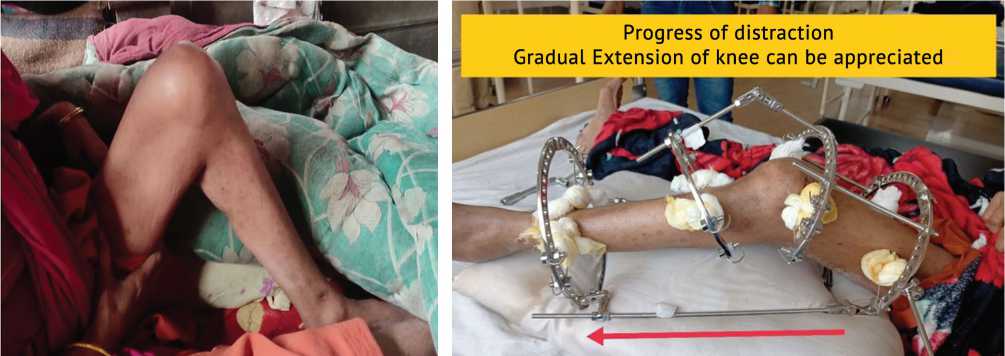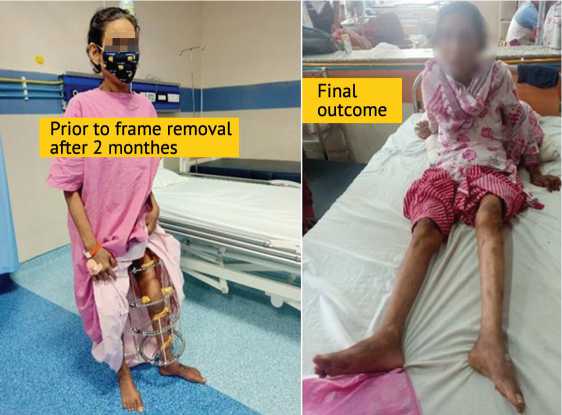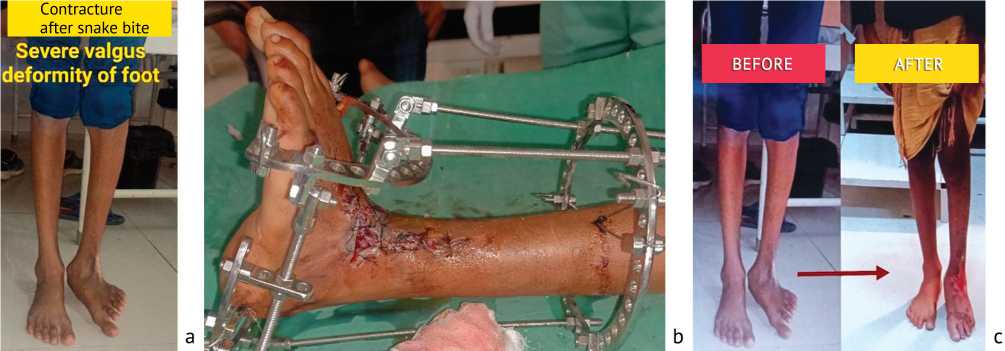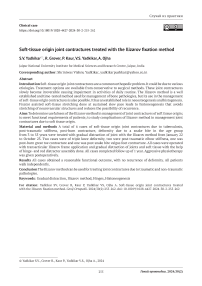Soft-tissue origin joint contractures treated with the Ilizarov fixation method
Автор: Yadkikar S. V., Grover R., Kaur P., Yadkikar V. S., Ojha A.
Журнал: Гений ортопедии @geniy-ortopedii
Рубрика: Случай из практики
Статья в выпуске: 2 т.30, 2024 года.
Бесплатный доступ
Introduction Soft-tissue origin joint contractures are a common orthopedic problem. It could be due to various etiologies. Treatment options are available from conservative to surgical methods. These joint contractures slowly become irreversible causing impairment in activities of daily routine. The Ilizarov method is a well established and time-tested method used for management of bone pathologies, but its use in the management of soft-tissue origin contractures is also possible. It has an established role in neoosteogenesis and histogenesis. Fixator assisted soft-tissue stretching done at sustained slow pace leads to histoneogenesis that avoids stretching of neurovascular structures and reduces the possibility of recurrence.Aims To determine usefulness of the Ilizarov method in management of joint contractures of soft tissue origin; to meet functional requirements of patients; to study complications of Ilizarov method in management joint contractures due to soft tissue origin.Material and methods A total of 6 cases of soft-tissue origin joint contractures due to tuberculosis, post-traumatic stiffness, post-burn contracture, deformity due to a snake bite in the age group from 3 to 55 years were treated with gradual distraction of joint with the Ilizarov method from January 22 to October 23. Two cases were of triple knee deformity, two were post-traumatic elbow stiffness, one was post-burn great toe contracture and one was post snake bite valgus foot contracture. All cases were operated with transarticular Ilizarov frame application and gradual distraction of joints and soft tissue with the help of hinge- and rod distractor assembly done. All cases completed follow up of 1 year. Aggressive physiotherapy was given postoperatively.Results All cases obtained a reasonable functional outcome, with no recurrence of deformity. All patients walk independently.Conclusion The Ilizarov method can be used for treating joint contractures due to traumatic and non-traumatic pathologies.
Gradual distraction, ilizarov method, hinges, histoneogenesis
Короткий адрес: https://sciup.org/142240823
IDR: 142240823 | УДК: 616.74/.75:616.72-009.12-001.5-089.227.84 | DOI: 10.18019/1028-4427-2024-30-2-255-262
Текст научной статьи Soft-tissue origin joint contractures treated with the Ilizarov fixation method
Joint contractures of soft-tissue origin are a common orthopedic problem [1, 2]. It could be due to idiopathic, infective, traumatic, post-burn or neuropathic etiologies. Management of these deformities has always been challenging not only in terms of gaining functional requirements of patients but also preventing recurrence. Multiple treatment options are available: from traction, splinting, casting, manipulation to surgical methods like osteotomies, soft tissue release, tendon transfer, scar excision and skin grafting [3]. Soft-tissue origin joint contractures slowly become irreversible causing impairment of activities of daily routine [4]. This demands surgical intervention to fulfill functional requirements of a patient. Acute correction of contractures may lead to skin necrosis, vascular compromise, nerve palsy, and recurrence is also frequent [1, 2, 5, 6]. Additional plastic surgical procedures may also be required [1, 7, 8].
The Ilizarov method is a well established and time tested method that is very frequently used for management of bone deformities, non-union, bone infection and complex trauma [1, 2, 9]. It is three dimensional, stable and minimally invasive fixation which allows not only deformity correction but also early functional rehabilitation [1, 2, 10, 11]. Dynamic deformity correction is possible during the entire treatment period [9].
Use of the Ilizarov method in the management of soft tissue contractures is also possible. Its role in neoosteogenesis and histogenesis has been very well proved [1, 12]. Gradual deformity correction by soft tissue stretching is possible with this method. Soft tissue stretching at sustained slow pace lead to histoneogenesis avoiding stretch damage to the neurovascular structures and the possibility of recurrence of the deformity is minimized [7, 8, 12].
Aims To determine usefulness of the Ilizarov method in management of joint contractures of soft tissue origin; to meet functional requirements of patients; to study complications of Ilizarov method in management joint contractures due to soft tissue origin.
MATERIAL AND METHODS
It was a prospective study in which a total of 6 cases of soft-tissue origin joint contractures were treated from January 2022 to October 2023. Amongst them, four cases were males and two females in the age from 3 years to 55 years. The study was initiated after receiving approval from the institutional ethics committee.
Etiology included :
-
— Two cases of severe flexion deformity of knee due to tuberculosis;
-
— Two cases of post-traumatic elbow stiffness;
-
— One case of post-burn contracture of the great toe and one case was post-snakebite valgus contracture of the foot;
Patient with active infection and neurovascular compromise were excluded from the study.
In all the cases, initial conservative treatment such as traction, splinting, manipulation was not done; and the patients did not undergo regular physiotherapy. Standard radiography of affected extremity joint was taken. The angle between the anterior cortical line and long bones was calculated to determine the extent of deformity. Pre-operative arterial color Doppler study was done in all cases. All cases were operated by one and the same surgeon.
Severe knee flexion deformity
Two cases with triple deformity of the knee (flexion, posterior subluxation, and external rotation) secondary to tuberculosis were treated with the Ilizarov method. Both patients were unable to stand and walk for one year.
After taking X-rays of the affected joint, the extent of deformity and the level of articular damage, if any, were determined. Trans-articular Ilizarov external fixation frames were applied fixing the femur and the tibia, perpendicular to the long axis of the shaft. Medial and lateral hinges were applied at the level of the knee. Threaded rods were placed along the posterior aspect of the knees and gradually distracted the knee at the rate of 2 degrees per day. Anti TB drugs were initiated after taking synovial tissue biopsy which was performed during frame application.
Post-traumatic elbow stiffness
Patients developed elbow stiffness following a compound run-over injury 2 years ago. During the initial insult, one patient also had head injury and she was in a comatose state for a long time that delayed orthopedic treatment and she developed flexion deformity. Since conservative management failed, operative management in the form of limited scar tissue release and Ilizarov frame application was done. Transarticular rings were applied to humerus and forearm in the midprone position. Medial and lateral hinges at the level of the elbow and an anterior distraction rod was applied. Distraction was done at the rate of 2 degrees per day. Serial checking X-rays were taken to determine elbow subluxation.
The other patient had post-traumatic elbow stiffness after being treated by a quack physician and was managed by us in the similar manner (Table 1).
Post-burn contracture of the great toe
It was flexion contracture at the interphalangeal and metatarsal phalangeal joint of the great toe due to post-burn scar in a 4-year old male.
A limited scar tissue excision and Z-plasty of flexor tendons was done followed by placement of a modified Ilizarov foot frame with medial and lateral hinges at the level of the metatarsal phalangeal joint to correct the associated adduction forefoot deformity and a puller rod to extend the interphalangeal and metatarsophalangeal joints gradually. Complete toe extension was achieved in 3 weeks’ time (Table 1).
Table 1
Patient characteristics
|
Age (years) |
Gender |
Joint involved |
Etiology |
Clinical presentation |
Pre-operative ROM (Degrees) |
Ilizarov frame duration (days) |
Post-operative ROM(degrees) |
Complications |
|
4 |
M |
Great toe DIP Joint |
Post-burn scar contracture |
Thick scar sole getting toe in flexion |
Extension — Not Possible |
21 |
Extension — 10 |
Pin tract infection |
|
Flexion — 40 |
Flexion — 0 |
|||||||
|
14 |
M |
Elbow |
Post-traumatic stiffness |
Healed scar over posterior surface |
Extension — 40 |
11 |
Extension — 25 |
— |
|
Flexion — 90 |
Flexion — 120 |
|||||||
|
21 |
F |
Healed scar over posterior and anterior surface |
Extension — 80 |
22 |
Extension — 30 |
Pin tract infection |
||
|
Flexion — 90 |
Flexion — 125 |
|||||||
|
55 |
F |
Knee |
Bone TB |
Triple deformity |
Extension — 80 |
45 |
Extension – 10 |
— |
|
Flexion — 90 |
Flexion — 120 |
|||||||
|
12 |
M |
Triple deformity |
Extension — 75 |
40 |
Extension — 0 |
Pin tract infection |
||
|
Flexion – 90 |
Flexion — 120 |
|||||||
|
16 |
M |
Ankle |
Postsnakebite contracture |
Plantar flexion and valgus deformity |
Plantar flexion — 20 |
15 |
Plantar flexion — 30 |
— |
|
Dorsiflexion — 10 |
Dorsiflexion — 25 |
|||||||
|
Supination — Not possible |
Supination — 20 |
|||||||
|
Pronation — 25 |
Pronation — 10 |
DIP — distal interphalangeal joint; TB — tuberculosis
Post-snakebite valgus foot contracture
It developed due to snakebite scar contracture in a 16-year old male.
Contracture evolved gradually over the period of 2 years following multiple debridement of the infected wound. The patient did not use splint. Scar tissue was released and then the frame was with hinges on either side of the ankle and a distraction rod anteriorly to correct the deformity. The ankle joint behaved as a natural hinge along which correction was done (Table 1).
Treatment period was divided in two phases:
Distraction continued during a dynamic phase. It was variable as per the extent of the deformity calculated preoperatively.
Static phase It was maintenance phase during which the soft tissues, being stretched fully, were maintained in overcorrected position. Its duration was twice longer of the dynamic phase.
During the entire treatment, the patients were ambulatory and encouraged to do regular exercises as per training.
In both phases aggressive physiotherapy is a key factor.
RESULTS
The average length of hospital stay was 3 weeks.
No case required secondary bone procedures like osteotomy along with frame application. The soft tissues were stretched to overcorrected position to prevent recurrence.
Limited soft tissue releases such as percutaneous tenotomy, percutaneous capsulotomy, scar tissue excision were done in one case of knee contracture, great toe contracture and foot contracture, respectively.
Distraction rate was calculated by initial deformity assessment on X-rays and also by the rule of triangle, and accordingly the estimated time of correction was also determined.
No neurovascular complication following distraction was noted in any case.
No joint dislocation or peri-articular fracture was seen.
No case required skin grafting.
Pin tract infection was detected in 3 cases which resolved with dressings and antibiotics.
No case required premature frame removal.
Treatment was divided in two phases, dynamic and static; fixator application time was variable depending upon pathology and deformity severity. However, average fixator application time was 6 weeks and soft tissues were maintained in overcorrected position for 2 more weeks in static phase, so average time for fixator removal was 8 weeks.
Post-operative use of splints was required in all cases to maintain soft tissue stretching and prevent recurrence. Initially, use of a splint continued for 1 month after frame removal and intermittent physiotherapy was encouraged. In later 6 months, night time splinting and intermittent daytime splinting continued.
Physiotherapy regimen: all patients were subjected for passive stretching, range of motion exercises. Patients were assessed at every visit for recurrence of deformity, range of motion and ability to perform activities of daily routine. Visits were made at 1, 3, 6, 12 months following initiation of treatment.
Average follow-up time was 1 year.
No evidence of recurrence of deformity was seen in any case; however post-frame splinting and aggressive physiotherapy has a pivotal role in preventing recurrence.
The objective of this treatment was to give reasonable function and aesthetic appearance to the limb which was achieved in this series to significant extent. Final outcome was determined by amount of flexion contracture calculated in degrees preoperatively and the residual one at the end of treatment. Accordingly, up to 5 degrees was excellent, up 15 degrees was good, up to 30 degrees was fair and more than 30 degrees was poor. Thus, one case was excellent, four cases were good and one patient had a poor result.

Fig. 1. Pre-operative flexion contracture of the knee
Fig. 2. Flexion contracture of the knee after frame application

Fig. 3. Knee contracture: final outcome

Fig. 4. Post-burn great toe contracture (a); soft tissue release (b)

Fig. 5. Correction achieved with frame (a); final outcome (b)

Fig. 6. Elbow flexion contracture (a); after frame application (b); elbow extension achieved (c)

Fig. 7. Post-snakebite foot contracture (a); frame applied (b); final outcome (c)
DISCUSSION
Management of deformities due to soft tissue contractures is challenging as treatment varies from conservative forms like splints, manipulations under anesthesia, physiotherapy to surgical intervention which includes osteotomies and at times plastic surgery [1, 2, 10, 13].
The Ilizarov fixation technique is widely used for management of bone deformities, complex fractures, bone loss, non-union and bone infection [1, 2, 12].
Its use for tissue growth and regeneration is accepted worldwide [1].
With due course of time the indications of the Ilizarov method have extended for management of non-traumatic deformities which are of soft tissue origin [6, 8, 9, 11, 14, 15, 16].
The use of this method for management of joint contractures, post-burn contractures, triple deformity, Volkman ischemic contracture has been reported [6, 15, 17].
Correction of deformity with the Ilizarov method is possible due to sustained controlled distraction of soft tissues leading to histoneogenesis [1, 2, 11, 17, 18, 19]. This process leads to progressive stretching of the juxta-articular and intra-articular connective tissues resulting in deformity correction. Gradual distraction process also leads to concomitant lengthening of blood vessels and nerves [2, 7, 8, 12, 14, 17, 18].
The hinge is a key component of the frame. Its place should be planned and done in appropriate manner to reduce the possibility of joint subluxation [2, 4, 11, 13]. Rate of distraction was calculated by initial deformity assessment on X-rays and also by rule of triangle, and estimated time of correction was also determined accordingly [2].
In our study, we have done preoperative arterial Doppler study of all patients, as soft tissue stretching might endanger the blood supply in patients with only single supplying blood vessel [1, 12]
No osteotomies were performed for deformity correction but overcorrection was done to reduce the recurrence rate [1, 3]. It is always good to start correction of the deformity as early as possible to gain good results [10].
In children the compliance for physiotherapy is lower; therefore this treatment can be considered as salvage treatment option [1, 14].
Patients are ambulatory during the entire process of treatment. Aggressive physiotherapy, post-frame splinting has equally an important role in preventing recurrence [6, 14, 15].
The Ilizarov fixator is a versatile, biomechanically stable, minimally invasive three dimensional construct which can be tailored as per need of deformity [1, 2, 4, 5, 6, 12, 16, 19]. This method permits dynamic deformity correction during the entire period of treatment and also allows weight-bearing [2, 7, 10, 13, 20]. It is known that the ideal way to avoid joint stiffness or contracture is complementary treatments such as aggressive physiotherapy and splinting [6, 14, 15, 17, 18]. In order to maintain long-term results and prevent recurrence post-frame splinting and aggressive physiotherapy is extremely important. Final outcomes were determined by residual amount of flexion contracture calculated in degrees, comparing the values at the beginning and at the end of treatment. Accordingly, up to 5 degrees was excellent, up 15 degrees was good, up to 30 degrees was fair and more than 30 degrees was poor [1, 2]. So, one case was an excellent result, 4 cases presented with good outcomes and, unfortunately, one patient had a poor prognosis. Though it was a small series but our results are parallel to the ones reported in the literature worldwide. However, to strengthen our conclusion a larger sample size with long follow-ups is required.
A short sample size was a limitation of our study and we plan to continue with our study prospectively, with a large number of subjects in the future.
CONCLUSION
The Ilizarov method can be used successfully for treating joint contractures of soft tissue origin due to traumatic and non-traumatic pathologies. It is a minimally invasive versatile method. It can be considered an addition to the armamentarium for treatment of joint soft-tissue origin contractures. However, exact positioning of hinges over the center of rotation of joint is mandatory. Detailed preoperative planning and postoperative execution are required to achieve desired results. For preventing recurrence, aggressive physiotherapy and splinting is equally important as frame application. Secondary procedures like osteotomies, skin grafting may be required and should be explained to the patient prior to the intervention.
No conflict of interest
No funding was received for study
Other authors helped in anesthesia, post-operative analgesia and data compilation and manuscript editing.
Список литературы Soft-tissue origin joint contractures treated with the Ilizarov fixation method
- Ullmann Y, Fodor L, Soudry M, Lerner A. The Ilizarov technique in joint contractures and dislocations. Acta Orthop Belg. 2007 Feb;73(1):77-82.
- Sud AD, Kaul R, Prasad M, et al. Gradual distraction for treatment of severe nee flexion contractures using the Ilizarov's apparatus. Int J Res Orthop. 2019;5:929-935. doi: 10.18203/issn.2455-4510
- van Roermund PM, van Valburg AA, Duivemann E, et al. Function of stiff joints may be restored by Ilizarov joint distraction. Clin Orthop Relat Res. 1998;(348):220-227.
- Pathania VP, Sharma AK, Joshi GR, John JT. Correction of Lower Limb Deformities Using Ilizarov's Technique. Med J Armed Forces India. 2005;61(4):322-5. doi: 10.1016/S0377-1237(05)80054-1
- Hosny GA, Fadel M. Managing flexion knee deformity using a circular frame. Clin Orthop Relat Res. 2008;466(12):2995-3002. doi: 10.1007/s11999-008-0530-y
- Huang SC. Soft tissue contractures of the knee or ankle treated by the Ilizarov technique. High recurrence rate in 26 patients followed for 3-6 years. Acta Orthop Scand. 1996;67(5):443-449. doi: 10.3109/17453679608996665
- Malkova TA, Borzunov DY. International recognition of the Ilizarov bone reconstruction techniques: Current practice and research (dedicated to 100th birthday of G.A. Ilizarov). World J Orthop. 2021;12(8):515-533. doi: 10.5312/wjo.v12.i8.515
- Brunner R, Hefti F, Tgetgel JD. Arthrogrypotic joint contracture at the knee and the foot: correction with a circular frame. J Pediatr Orthop B. 1997;6(3):192-197. doi: 10.1097/01202412-199707000-00007
- Calhoun JH, Evans EB, Herndon DN. Techniques for the management of burn contractures with the Ilizarov Fixator. Clin Orthop Relat Res. 1992;(280):117-124.
- Herzenberg JE, Davis JR, Paley D, Bhave A. Mechanical distraction for treatment of severe knee flexion contractures. Clin Orthop Relat Res. 1994;(301):80-88.
- Macwilliams BA, Harjinder B, Stevens PM. Guided growth for correction of knee flexion deformity: a series of four cases. Strategies Trauma Limb Reconstr. 2011;6(2):83-90. doi: 10.1007/s11751-011-0110-7
- Chen Y, Niu Z, Yin X, et al. Treatment of Severe Postburn Contracture of the Elbow via Distraction With External Circular Frame in Pediatric Patient. Ann Plast Surg. 2021;87(3):253-259. doi: 10.1097/SAP.0000000000002960
- Grant AD, Atar D, Lehman WB. The Ilizarov technique in correction of complex foot deformities. Clin Orthop Relat Res. 1992;(280):94-103.
- Damsin JP, Ghanem I. Treatment of severe flexion deformity of the knee in children and adolescents using the Ilizarov technique. J Bone Joint Surg Br. 1996;78(1):140-144.
- Madhuri V, Dhanraj P. Correction of post burns contracture of wrist with Ilizarov method. Burns. 1998;24(6):576-578. doi: 10.1016/s0305-4179(98)00055-2
- Xia LW, Xu C, Huang JH. Use of Ilizarov technique for bilateral knees flexion contracture in Juvenile-onset ankylosing spondylitis: A case report. World J Clin Cases. 2023;11(29):7179-7186. doi: 10.12998/wjcc.v11.i29.7179
- Ilizarov GA. The tension-stress effect on the genesis and growth of tissues. Part I. The influence of stability of fixation and soft-tissue preservation. Clin Orthop Relat Res. 1989;(238):249-281.
- Ilizarov GA. Clinical application of the tension-stress effect for limb lengthening. Clin Orthop Relat Res. 1990;(250):8-26.
- Sun J, Li O, Gao F, et al. Application of the Ilizarov technique for knee joint arthrodesis as a treatment for end-stage tuberculosis of the knee. BMCMusculoskeletDisord. 2020;21(1):579. doi: 10.1186/s12891-020-03603-9.
- Bruno AA, Kirienko A, Peccati A, et al. Knee arthrodesis by the Ilizarov method in the treatment of total knee arthroplasty failure. Knee. 2017;24(1):91-99. doi: 10.1016/j.knee.2016.11.002


